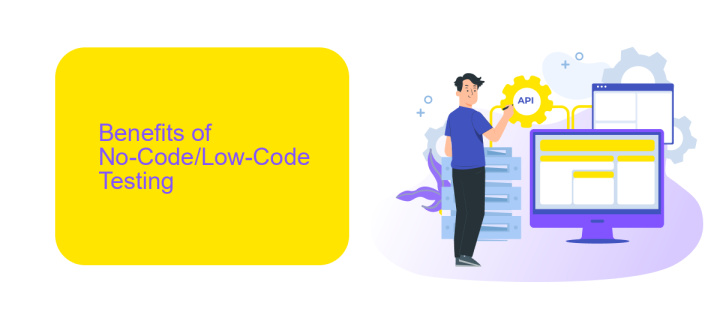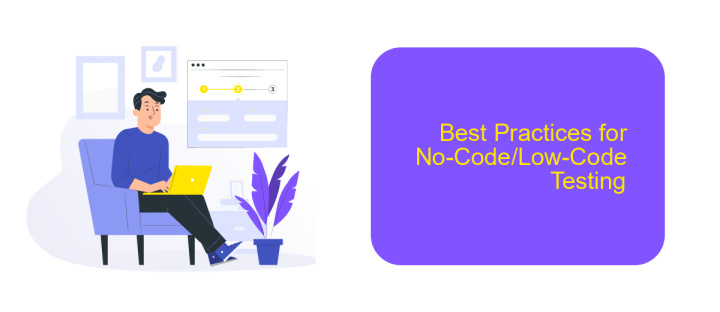No-Code Low-Code Testing
In today's fast-paced digital landscape, the demand for rapid software development has never been higher. No-Code and Low-Code platforms are revolutionizing the way applications are built, enabling even non-technical users to create robust solutions. This article explores the importance of No-Code and Low-Code testing, ensuring that these innovative platforms deliver reliable and high-quality software.
Introduction to No-Code/Low-Code Testing
No-Code/Low-Code Testing is revolutionizing the software development landscape by enabling individuals without extensive coding knowledge to create and execute tests. This approach democratizes the testing process, making it accessible to a broader audience and fostering collaboration between technical and non-technical team members.
- Reduces development time and costs
- Empowers non-developers to participate in testing
- Facilitates faster feedback and iteration cycles
- Enhances collaboration across teams
Leveraging tools like ApiX-Drive, teams can easily integrate various services and automate workflows without writing a single line of code. This streamlines the testing process and ensures that all necessary components are seamlessly connected. As a result, No-Code/Low-Code Testing not only boosts efficiency but also enhances the overall quality of software products.
Benefits of No-Code/Low-Code Testing

No-Code/Low-Code Testing offers numerous benefits that make it an attractive option for organizations looking to streamline their software development processes. One of the primary advantages is the significant reduction in time and resources required to create and execute tests. With intuitive drag-and-drop interfaces, even non-technical team members can design and run tests, allowing for faster iteration and more comprehensive test coverage. This democratization of testing not only accelerates the development cycle but also ensures that quality assurance is a collective responsibility, leading to more robust and reliable software products.
Another key benefit is the ease of integration with existing tools and services, which can further enhance the testing process. For instance, platforms like ApiX-Drive enable seamless integration of various applications and services without the need for complex coding. This capability allows teams to automate workflows, synchronize data, and manage test environments more efficiently. By leveraging such integrations, organizations can achieve a higher level of automation and coordination, ultimately improving the overall efficiency and effectiveness of their testing strategies.
Challenges in No-Code/Low-Code Testing

Despite the numerous advantages of no-code/low-code testing, there are several challenges that testers and developers face. These platforms often promise rapid development and deployment, but they come with their own set of limitations.
- Limited Customization: No-code/low-code platforms often provide pre-built templates and components, which can be restrictive when it comes to unique or highly specific requirements.
- Integration Issues: Integrating with existing systems can be complex. Although services like ApiX-Drive can facilitate these integrations, there can still be compatibility issues and data synchronization problems.
- Scalability Concerns: As projects grow, the limitations of the no-code/low-code platform can become more apparent, potentially requiring a shift to more traditional coding methods.
- Security Risks: The ease of use of these platforms can sometimes lead to overlooked security vulnerabilities, making thorough testing and validation essential.
Addressing these challenges requires a balanced approach, combining the ease of no-code/low-code platforms with traditional development practices where necessary. Leveraging integration tools like ApiX-Drive can help mitigate some of these issues, ensuring smoother workflows and better overall project outcomes.
Best Practices for No-Code/Low-Code Testing

Implementing best practices in no-code/low-code testing can significantly enhance the quality and reliability of your applications. Start by defining clear testing objectives to ensure that all critical functionalities are covered. It's essential to maintain a well-documented testing process that includes detailed test cases and expected outcomes.
Leverage automated testing tools to streamline repetitive tasks and reduce human error. Utilize services like ApiX-Drive for seamless integration and data synchronization between different platforms, which can help in executing end-to-end tests effectively. Regularly update your testing framework to adapt to new features and changes in the application.
- Define clear testing objectives
- Maintain detailed documentation
- Leverage automated testing tools
- Utilize integration services like ApiX-Drive
- Regularly update the testing framework
Continuous monitoring and feedback are crucial for improving the testing process. Encourage collaboration between developers and testers to identify and resolve issues promptly. By following these best practices, you can ensure a robust and efficient no-code/low-code testing strategy.


Future of No-Code/Low-Code Testing
The future of No-Code/Low-Code testing looks promising as it continues to democratize the testing process, allowing individuals without extensive coding knowledge to participate in creating and maintaining test cases. This shift is expected to lead to faster development cycles, reduced costs, and increased collaboration between technical and non-technical team members. As more organizations adopt these platforms, the demand for skilled testers who can leverage No-Code/Low-Code tools will grow, further driving innovation in this space.
One of the key advancements in this area is the integration of various services to streamline workflows and enhance efficiency. For instance, platforms like ApiX-Drive enable seamless integration between different applications, allowing testers to automate data transfer and synchronization without writing a single line of code. Such integrations will become increasingly vital, empowering teams to build more robust and scalable testing frameworks. As these tools evolve, we can expect even greater capabilities, making No-Code/Low-Code testing an indispensable part of the software development lifecycle.
FAQ
What is No-Code/Low-Code Testing?
How does No-Code/Low-Code Testing benefit my team?
Can No-Code/Low-Code Testing handle complex test scenarios?
What types of applications can be tested using No-Code/Low-Code platforms?
How can I integrate No-Code/Low-Code Testing with my existing tools?
Do you want to achieve your goals in business, career and life faster and better? Do it with ApiX-Drive – a tool that will remove a significant part of the routine from workflows and free up additional time to achieve your goals. Test the capabilities of Apix-Drive for free – see for yourself the effectiveness of the tool.

